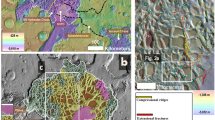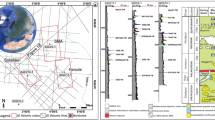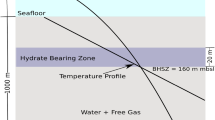Abstract
Hundreds of newly discovered gas seeps, craters, and mounds are presented from the central Barents Sea, Norway. Where they occur together, the crater-mound pairs have a preferred orientation towards the southeast. According to complex cross-cutting relationships with iceberg ploughmarks, both the craters and mounds formed during deglaciation (ca. 11–13 ka BP). Free gas, trapped beneath shallow gas hydrates in discrete areas, deformed or displaced overlying bedrock and sediment, forming mounds. Over-steepened slopes, weak layers, fractured bedrock, and unstable sediment resulted in small landslides towards the southeast: the direction of regional slope. In some cases, the highly buoyant, hydrate-cored sediment mounds may have instead, detached and floated with bottom currents before being re-deposited, either locally or distally. In this scenario, southeasterly flowing bottom currents would also explain the preferred orientation of the observed crater-mound pairs. Crater collapse would have occurred simultaneously or subsequently to landslide or detachment and floating due to the rapid dissociation of any remaining gas hydrates; a result of attendant regional changes in temperature and pressure following deglaciation and local removal of overlying sediment. The model of formation developed in this study explains the southeasterly trend in crater-mound orientation, but differs from other studies that interpret modern mounds, located elsewhere in the Barents Sea, as gas hydrate-cored.




Similar content being viewed by others
References
Aagaard-Sørensen S, Groot DE, Husum K, Hald M (2013) Paleoceanographic reconstruction in the western and northern Barents Sea during and after the last deglaciation. In: EGU General Assembly Abstracts, EGU2013–2766
Andreassen K, Laberg JS, Vorren TO (2008) Seismic seafloor geomorphology of the SW Barents Sea and its glaci-dynamic implications. Geomorphology 97:157–177
Andreassen K, Hubbard A, Winsborrow M, Patton H, Vadakkepuliyambatta S, Plaza-Faverola A, Gudlaugsson E, Serov P, Deryabin A, Mattingsdal R, Mienert J, Bünz S (2017) Massive blow-out craters formed by hydrate-controlled methane expulsion from the Arctic seafloor. Science 356:948–953
Andreassen K, Winsborrow MCM, Bjarnadóttir LR, Rüther DC, (2014) Ice stream retreat dynamics inferred from an assemblage of landforms in the northern Barents Sea. Quat Sci Rev 92:246-257
Anell I, Faleide J-I, Braathen A (2016) Regional tectono-sedimentary development of the highs and basins of the northwestern Barents Shelf. Nor J Geol 96:27–41
Bellec VK, Bøe R, Rise L, Lepland A, Thorsnes T, Bjarnadóttir LR (2017) Seabed sediments (grain size) of Nordland VI, offshore North Norway. J Maps 13:608–620
Biastoch A, Treude T, Rüpke LH, Riebesell U, Roth C, Burwicz EB, Park W, Latif M, Böning CW, Madec G, Wallmann K (2011) Rising Arctic Ocean temperatures cause gas hydrate destabilization and ocean acidification. Geophys Res Lett L08602. https://doi.org/10.1029/2011GL047222
Bjarnadóttir LR, Winsborrow M, Andreassen K (2014) Deglaciation of the Central Barents Sea. Quat Sci Rev 92:208–226
Bjarnadóttir LR, Ottensen D, Dowdeswell JA, Bugge T (2016) Unusual iceberg ploughmarks on the Norwegian continental shelf. Geol Soc Lond Mem 46:283–284
Brewer PG, Paull C, Peltzer ET, Ussler W, Rehder G, Friederich G (2002) Measurements of the fate of gas hydrates during transit through the ocean water column. Geophys Res Lett 29:38–1-38-4
Crémière A, Lepland A, Chand S, Sahy D, Condon DJ, Noble SR, Toñu M, Thorsnes T, Sauer S, Brunstad H (2016) Timescales of methane seepage on the Norwegian margin following collapse of the Scandinavian ice sheet. Nat Commun 7(11509). https://doi.org/10.1038/ncomms11509
Elverhøi A, Solheim A (1983) The Barents Sea ice sheet: a sedimentological discussion. Polar Res 1:23–42
Fader G (1991) Gas-related sedimentary features from the eastern Canadian continental shelf. Cont Shelf Res 11:1123–1153
Forman S, Lubinski D, Miller GH, Snyder J, Matishov G, Korsun S, Myslivets V (1995) Postglacial emergence and distribution of Late Weichselian ice-sheet loads in the northern Barents and Kara seas, Russia. Geology 23:113–116
Gabrielsen RH, Færseth RB, Jensen LN, Kalheim JE, Riis F (1990) Structural elements of the Norwegian continental shelf part I: the Barents Sea region, NPD Bulletin No. 6
Hammer Ø, Webb KE, Depreiter D (2009) Numerical simulation of upwelling currents in pockmarks and data from the inner Oslofjord, Norway. Geo-Mar Lett 29:269–275
Hogan KA, Dowdeswell JA, Hillenbrand C-D, Ehrmann W, Noormets R, Wacker L (2017) Subglacial sediment pathways and deglacial chronology of the northern Barents Sea ice sheet. Boreas 46:750–771
Hong W-L, Torres ME, Carroll J, Crémière A, Panier G, Yao H, Serov P (2017) Seepage from an arctic shallow marine gas hydrate reservoir is insensitive to momentary ocean warming. Nat Commun 8:15745. https://doi.org/10.1038/ncomms15745
Jung W-Y, Vogt PR (2004) Effects of bottom water warming and sea-level rise on Holocene hydrate dissociation and mass wasting along the Norwegian-Barents continental margin. J Geophys Res 109. https://doi.org/10.1029/2003JB002738
King LH, MacLean B (1970) Pockmarks on the Scotian shelf. Geol Soc Am Bull 81:3141–3148
King EL, Rise L, Bellec VK (2016) Crescentic submarine hills and holes produced by iceberg calving and rotation. Geol Soc Lond Mem 46:267–268
Lambeck K (1995) Constraints on the Late Weichselian ice sheet over the Barents Sea from observations of raised shorelines. Quat Sci Rev 14:1–16
Lambek K (1996) Limits on the areal extent of the Barents Sea ice sheet in Late Weichselian time. Glob Planet Chang 12:41–51
Landvik JY, Bondevik S, Elverhøi A, Fjeldskaar W, Mangerud J, Salvigsen O, Siegert JI, Svendsen J-I, Vorren TO (1998) The last glacial maximum of Svalbard and the Barents Sea area: ice sheet extent and configuration. Quat Sci Rev 17:43–75
Long D, Lammers S, Linke P (1998) Possible hydrate mounds within large sea-floor craters in the Barents Sea. Geol Soc Lond Spec Publ 137:223–237
Micallef A, Masson DG, Berndt C, Stow DAV (2009) Development and mass movement processes of the north-eastern Storegga slide. Quat Sci Rev 28:433–448
Moran SR, Clayton L, Hooke RL, Fenton MM, Andriashek LD (1980) Glacier-bed landforms of the prairie region of North America. J Glaciol 25:457–476
Newton AMW, Huuse M (2017) Glacial geomorphology of the Central Barents Sea: implications for the dynamic deglaciation of the Barents Sea ice sheet. Mar Geol 387:114–131
Ottesen D, Dowdeswell JA, Rise L (2005) Submarine landforms and the reconstruction of fast-flowing ice streams within a large Quaternary ice sheet: the 2500 km-long Norwegian-Svalbard margin (57°-80°N). Geol Soc Am Bull 117:1033–1050
Portnov A, Vadakkepuliyambatta S, Mienert J, Hubbard A (2016) Ice-sheet-driven methane storage and release in the Arctic. Nat Commun 7. https://doi.org/10.1038/ncomms10314
Rise L, Bellec VK, Ottesen D, Bøe R, Thorsnes T (2016) Hill-hole pairs on the Norwegian continental shelf. Geol Soc Lond Mem 46:203–204
Rogers J, Kelley JT, Belknap DF, Gontz A, Barnhardt WA (2006) Shallow-water pockmark formation in temperate estuaries: a consideration of origins in the western Gulf of Maine with special focus on Belfast Bay. Mar Geol 225:45–62
Rüther DC, Mattingsdal R, Andreassen K, Forwick M, Husum K (2011) Seismic architecture and sedimentology of a major grounding zone system deposited by the Bjørnøyrenna ice stream during the Late Weichselian deglaciation. Quat Sci Rev 30:2776–2792
Rüther DC, Bjarnadóttir LR, Junttila J, Husum K, Rasmussen TL, Lucchi RG, Andreassen K (2012) Pattern and timing of the northwestern Barents Sea ice sheet deglaciation and indications of episodic Holocene deposition. Boreas 41:494–512
Salvigsen O (1981) Radiocarbon Dated Raised Beaches in Kong Karls Land, Svalbard, and Their Consequences for the Glacial History of the Barents Sea Area. Geogr Ann Ser B 63:283-291
Sættem J (1990) Glaciotectonic forms and structures on the Norwegian continental shelf: observations, processes and implications. Nor Geol Tidsskr 70:81–94
Serov P, Vadakkepuliyambatta S, Mienert J, Patton H, Portnov A, Silyakova A, Panieri G, Carroll ML, Carroll J, Andreassen K, Hubbard A (2017) Postglacial response of Arctic Ocean gas hydrates to climatic amelioration. PNAS 114:6215–6220
Sloan ED, Koh C (2007) Clathrate hydrates of natural gases, 3rd edn. CRC Press, Boca Raton, Fla
Solheim A, Elverhøi A (1993) Gas-related sea floor craters in the Barents Sea. Geo-Mar Lett 3:11–19
Solheim A, Kristoffersen Y (1984) Physical environment Western Barents Sea, 1: 1,500,000; sediments above the upper regional unconformity: thickness, seismic stratigraphy and outline of the glacial history. Nor Polarinst Skr 179B:3–26
Stokes CR, Clark CD (1999) Geomorphological criteria for identifying Pleistocene ice streams. Ann Glaciol 28:67–74
Suess E, Torresb ME, Bohrmanna G, Collierb RW, Greinerta J, Linke P, Rehder G, Trehu A, Wallmann K, Winckler G, Zuleger E (1999) Gas hydrate destabilization: enhanced dewatering, benthic material turnover and large methane plumes at the Cascadia convergent margin. Earth Planet Sci Lett 170:1–15
Svendsen JI, Gataullin V, Mangerud J, Polyak L (2004) The glacial history of the Barents and Kara Sea region. In: Ehlers J, Gibbard PL (eds) Quaternary glaciations—extent and chronology part 1: Europe. Elsevier B.V, Amsterdam
Vogt PR, Jung W-Y (2002) Holocene mass wasting on upper non-polar continental slopes—due to post-Glacial Ocean warming and hydrate dissociation? Geophys Res Lett 29:1341
Wallmann K, Riedel M, Hong WL, Patton H, Hubbard A, Pape T, Hsu CW, Schmidt C, Johnson JE, Torres ME, Andreassen K, Berndt C, Bohrmann G (2018) Gas hydrate dissociation off Svalbard induced by isostatic rebound rather than global warming. Nat Commun 9:83. https://doi.org/10.1038/s41467-017-02550-9
Winsborrow M, Andreassen K, Corner GD, Laberg JS (2010) Deglaciation of a marine-based ice sheet: late Weichselian palaeo-ice dynamics and retreat in the southern Barents Sea reconstructed from onshore and offshore glacial geomorphology. Quat Sci Rev 29:424–442
Winsborrow M, Andreassen K, Hubbard A, Plaza-Faverola A, Gudlaugsson E, Patton H (2016) Regulation of ice stream flow through subglacial formation of gas hydrates. Nat Geosci 9:370–375
Zatsepina OY, Buffett BA (1998) Thermodynamic conditions for the stability of gas hydrate in the seafloor. J Geophys Res 103(B10):24127–24139
Acknowledgments
We gratefully acknowledge Kartverket (The Norwegian Hydrographic Service), the Geological Survey of Norway, and MAREANO for providing the high-resolution bathymetry, acoustic backscatter, and water column backscatter data used in this study. Thanks also to Edward L. King, Geological Survey of Canada, for his insightful comments on our interpretations of the data, and to two anonymous reviewers whose comments and suggestions helped improve the manuscript.
Author information
Authors and Affiliations
Corresponding author
Additional information
Publisher’s note
Springer Nature remains neutral with regard to jurisdictional claims in published maps and institutional affiliations.
Rights and permissions
About this article
Cite this article
Nixon, F.C., Chand, S., Thorsnes, T. et al. A modified gas hydrate-geomorphological model for a new discovery of enigmatic craters and seabed mounds in the Central Barents Sea, Norway. Geo-Mar Lett 39, 191–203 (2019). https://doi.org/10.1007/s00367-019-00567-1
Received:
Accepted:
Published:
Issue Date:
DOI: https://doi.org/10.1007/s00367-019-00567-1




